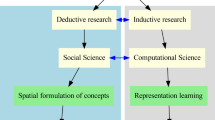Abstract
Each natural language phrase is evidence for a particular strategy of construing reality. One domain where this has been extensively studied is spatial language, which reveals an enormous amount of variation of conceptualization strategies both within a particular language and cross-culturally. This paper proposes a computational formalism for representing conceptualization strategies and shows how the formalism can be used to study and explain the evolution and emergence of spatial conceptualization strategies and their impact on shared grounded communication systems.








Similar content being viewed by others
Notes
α is given by the experimenter and in all experiments described here α=0.5.
References
Bleys J (2010) Language strategies for the domain of colour. PhD thesis, Vrije Universiteit Brussels (VUB), Brussels, Belgium
Bleys J, Loetzsch M, Spranger M, Steels L (2009) The grounded color naming game. In: Proceedings of the 18th IEEE international symposium on robot and human interactive communication (Ro-man 2009)
Cangelosi A (2010) Grounding language in action and perception: from cognitive agents to humanoid robots. Phys Life Rev 7(2):139–151
De Beule J, Bergen B (2006) On the emergence of compositionality. In: Cangelosi A, Smith ADM, Smith K (eds) The evolution of language (Evolang 6). World Scientific, Singapore, pp 35–42
Fujita M, Kuroki Y, Ishida T, Doi T (2003) Autonomous behavior control architecture of entertainment humanoid robot SDR-4X. In: IEEE/RSJ international conference on intelligent robots and systems, pp 960–967
Johnson-Laird PN (1977) Procedural semantics. Cognition 5(3):189–214
Kirby S (2002) The evolution of language. Artif Life 8:185–215
Levinson SC (1996) Language and space. Annu Rev Anthropol 25(1):353–382
Levinson SC (2003) Space in language and cognition: explorations in cognitive diversity. Language, culture and cognition, vol 5. Cambridge University Press, Cambridge
Levinson SC, Wilkins D (2006) Grammars of space. Cambridge University Press, Cambridge
Mainwaring S, Tversky B, Ohgishi M, Schiano D (2003) Descriptions of simple spatial scenes in English and Japanese. Spat Cogn Comput 3(1):3–42
Marocco D, Cangelosi A, Nolfi S (2003) The emergence of communication in evolutionary robots. Philos Trans R Soc, Math Phys Eng Sci 361(1811):2397
Smith K, Brighton H, Kirby S (2003) Complex systems in language evolution: the cultural emergence of compositional structure. Adv Complex Syst 6(4):537–558
Smith K, Kirby S, Brighton H (2003) Iterated learning: a framework for the emergence of language. Artif Life 9(4):371–386
Spranger M (2008) World models for grounded language games. German diploma thesis. Humboldt-Universität zu Berlin
Spranger M (2011) The evolution of grounded spatial language. PhD thesis, Vrije Universiteit Brussels (VUB), Brussels, Belgium
Spranger M (2012) The co-evolution of basic spatial terms and categories. In: Steels L (ed) Experiments in cultural language evolution. Benjamins, Amsterdam, pp 111–141
Spranger M, Loetzsch M (2011) Syntactic indeterminacy and semantic ambiguity: a case study for German spatial phrases. In: Steels L (ed) Design patterns in fluid construction grammar. Constructional approaches to language, vol 11. Benjamins, Amsterdam, pp 265–298
Spranger M, Steels L (2012) Emergent functional grammar for space. In: Steels L (ed) Experiments in cultural language evolution. Benjamins, Amsterdam, pp 207–232
Spranger M, Loetzsch M, Pauw S (2010) Open-ended grounded semantics. In: Coelho H, Studer R, Woolridge M (eds) Proceedings of the 19th European conference on artificial intelligence (ECAI 2010). Frontiers in artificial intelligence and applications. IOS Press, Amsterdam, pp 929–934
Spranger M, Loetzsch M, Steels L (2012) A perceptual system for language game experiments. In: Steels L, Hild M (eds) Language grounding in robots. Springer, Berlin, pp 89–110
Spranger M, Pauw S, Loetzsch M, Steels L (2012) Open-ended procedural semantics. In: Steels L, Hild M (eds) Language grounding in robots. Springer, Berlin, pp 153–172
Steels L (1995) A self-organizing spatial vocabulary. Artif Life 2(3):319–332
Steels L (2000) The emergence of grammar in communicating autonomous robotic agents. In: Horn W (ed) ECAI 2000: proceedings of the 14th European conference on artificial intelligence. IOS, Amsterdam, pp 764–769
Steels L (2002) Grounding symbols through evolutionary language games. In: Simulating the evolution of language. Springer, New York, pp 211–226
Steels L (2007) The recruitment theory of language origins. In: Lyon C, Nehaniv C, Cangelosi A (eds) The emergence of communication and language. Springer, Berlin, pp 129–151
Steels L, Hild M (eds) (2012) Language grounding in robots. Springer, Berlin
Steels L, Spranger M (2012) Emergent mirror systems for body language. In: Steels L (ed) Experiments in cultural language evolution. John Benjamins, Amsterdam, pp 87–109
Tenbrink T (2007) Space, time, and the use of language: an investigation of relationships. Cognitive linguistics research, vol 36. Walter de Gruyter, Berlin
Tenbrink T (2011) Reference frames of space and time in language. J Pragmat 43(3):704–722
Vogt P (2006) Overextensions and the emergence of compositionality. In: Cangelosi A, Smith ADM, Smith K (eds) The evolution of language (Evolang 6). World Scientific, Singapore, pp 364–371
Vogt P, Divina F (2007) Social symbol grounding and language evolution. Interact Stud 8(1):31–52
Acknowledgements
I am greatly indebted to Masahiro Fujita and Hideki Shimomura for supporting this research. I thank Simon Pauw, Martin Loetzsch, Wouter van den Broeck, Joris Bleys and Luc Steels who have made contributions to aspects of IRL.
Author information
Authors and Affiliations
Corresponding author
Rights and permissions
About this article
Cite this article
Spranger, M. Evolving Grounded Spatial Language Strategies. Künstl Intell 27, 97–106 (2013). https://doi.org/10.1007/s13218-013-0245-4
Received:
Accepted:
Published:
Issue Date:
DOI: https://doi.org/10.1007/s13218-013-0245-4




